LOOKING BACK ON : THE MAKING OF A REVOLUTION : Political Scientist’s New Book Analyzes Forces That Shaped Santa Monica Rent Control
The left-wing political activists who stormed to power in Santa Monica on promises of social and economic reform have suffered from a lack of leadership and enthusiasm in recent years but remain a vital force in the city.
That is the conclusion of Mark E. Kann, a USC political science professor who has written a controversial new book called “Middle Class Radicalism in Santa Monica,” a critical evaluation of the tenant activist movement that spawned revolutionary changes in Santa Monica politics in the late 1970s.
Kann, who writes widely on political issues, both praises and condemns the people responsible for the “radicalization” of Santa Monica. The residents who mobilized under the name Santa Monicans for Renters’ Rights have been strong on environmental and social service issues, according to Kann, but have failed to realize their goals of helping small businessmen, minorities and women.
“I think they are radical in theory,” said Kann, who subtitled one chapter of his book “Joggers Cannot Be Revolutionaries.” “But various (goals) have been compromised. . . . In that sense they dream radical dreams, but they have become political pragmatists.”
Critics, however, said that Kann overlooked many of the group’s accomplishments and that, far from being an organization of radicals, it pursued the American way of doing things.
Kann supports his theories with a fairly exhaustive review of the past seven
years of Santa Monica politics--from the birth of the city’s successful rent control movement in 1979, to the defeat of political conservatives at City Hall in 1981, to the mishaps that cost the tenant activists their City Council majority in 1984.
People familiar with Santa Monica said that Kann has probably produced the longest account of the city’s tenant movement. At nearly 300 pages it can hardly be considered light reading. But Kann said he hopes the book will find an audience in a city known for its rabid interest in politics.
The scholarly tome includes interviews with most of the major participants in the city’s tenant movement. It is slowly making its way through the left-wing ranks, but has already been criticized by some prominent activists.
Derek Shearer, a founder of Santa Monicans for Renters’ Rights and the husband of Ruth Yannatta Goldway, the city’s first “radical” mayor, said Kann overlooked many of the group’s accomplishments. He was especially critical of Kann’s theory that rent control has done little to help the poor.
“If you look at who rent control helps most, it obviously helps low-income people and low-income seniors who would have otherwise been thrown out of the city,” Shearer said. “(That fact) couldn’t be clearer.”
Shearer also objected to Kann calling the movement’s leadership radical.
“His whole thesis is manufactured,” Shearer said. “Our group . . . is very much composed of liberal or progressive Democrats. We engaged in electoral politics. We didn’t hold demonstrations. We didn’t march. We just ran for office, which is a pretty American way of doing things.”
City Atty. Robert M. Myers, who wrote the rent control law, said the book is an “interesting but not completely accurate” account of recent political events. Councilman Dennis Zane, described by Kann as the driving force behind the
tenant movement, said he plans to read the book soon. But based on what he has heard, Zane said Kann incorrectly implies that the rent control movement was led and supported by middle-class “quiche and Perrier” people.
“The book appears to reduce Santa Monicans for Renters’ Rights to the image of a few affluent and visible personalities when in fact we have never been led by such people,” Zane said. “These are working blue- and white- collar people who are neither affluent nor addicted to quiche and Perrier.”
Kann said he expects the book to generate some controversy, especially among tenant activists. But the 39-year-old San Pedro resident, who has written several newspaper and magazine articles on Santa Monica politics, said he considers it an accurate and useful account of a turbulent period in the city’s history.
The tenant movement, which came about as a result of frustration with the rampant development and skyrocketing housing costs of the 1970s, focused national attention on Santa Monica, once considered a sleepy beach town. The fact that residents united against growth is not unusual, Kann contends. More peculiar was that so many middle-class citizens united to form a political coalition with such radical ideals.
“Santa Monica residents, activists, politicians and bureaucrats all betrayed the distinctive signs of middle-class background and culture,” Kann wrote. “They were generally affluent, highly educated, articulate, cosmopolitan, self-confident and effective. They lived the American dream and yet they sought
to fulfill radical dreams.”
The most obvious manifestation of the “radical dream” is the city’s rent control law, widely considered one of the nation’s toughest. There have also been improvements in social services. Overall, however, Kann contends that Santa Monicans for Renters’ Rights has failed to meet its ultimate goals because of the lack of a strong economic policy and a failure to reach out to minorities.
The group, which had gained a council majority in 1981 with the support of the city’s sizable tenant population, saw Mayor Goldway defeated in 1983. And it lost the council majority in 1984, after Councilwoman Dolores Press failed to gather enough signatures to qualify for the ballot. Since then it has been striving to regroup and strengthen voter support for coming elections.
Kann said he is optimistic about the organization’s political future. Santa Monicans for Renters’ Rights will try to regain a majority of the City Council seats in November, and Kann said he expects the organization to run a formidable campaign, especially if it strengthens its leadership.
“I don’t think they have lost their popularity at the polls,” Kann said. “What has changed is that they don’t have a central figure like Goldway to galvanize them. What left with Ruth (Goldway) were their priorities.”
More to Read
Sign up for our Book Club newsletter
Get the latest news, events and more from the Los Angeles Times Book Club, and help us get L.A. reading and talking.
You may occasionally receive promotional content from the Los Angeles Times.









